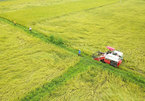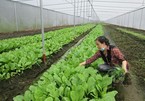 |
|
|
Presence Nutrition, a mobile app developed by French feed company Neovia Vietnam providing up-to-date market information for farmers, is considered an expert source of knowledge about animal nutrition.
Launched in October last year, within just a year it has been downloaded 9,600 times around the country. With an easy-to-use interface, the app is a useful tool for farmers to check daily prices in livestock markets, be alerted about local diseases, receive local weather forecasts, and find nutritional information needed for each type of animal.
Utilizing high-tech apps in farming is seen as an essential move by agricultural enterprises in Vietnam, especially large concerns that have invested heavily in digital farming in order to create a digitalized agriculture supply chain, minimize costs, and enhance productivity.
Towards high-tech farming
As Vietnam’s population continues to grow and smartphone use takes hold, agricultural methods must also evolve and it’s time to take advantage of technology and the digital revolution, according to Mr. Christophe Guillaume, CEO of Neovia Vietnam.
“Digital technologies are rapidly transforming the local agriculture sector in terms of data, forecasting analytics, artificial intelligence (AI), and general farming management that saves farmers time and money while being accurate and remarkably efficient,” he said.
As one of the leading animal nutrition producers, Neovia has been investing in innovation through many major projects from the corporate to country level globally.
In Vietnam, apart from Presence Nutrition, Neovia Vietnam also launched an official page on the Zalo platform, Anh Ba Chuan, last April, with information on standard nutrition, standard watering, and standard models. It has 6,000 followers and a chatbot.
Like the Presence Nutrition app, Anh Ba Chuan offers a range of technical advice, disease prevention methods, and the latest market prices.
Despite a year full of challenges for the swine business in Vietnam due to African Swine Fever (ASF), animal breeding companies around the country still have clear policies to focus on technological innovation.
“Many of our facilities have been automated in order to eliminate human error and other missteps,” Mr. Montri Suwanposri, President of CP Vietnam, told VET.
“For example, we are now constructing a new export chicken facility in southern Binh Phuoc province that will be the most modern in Vietnam when opened next year.”
CP Vietnam has been developing standards particular to farming. “We are trying to apply technologies in order to make our work easier and more accurate,” he said.
“There are some phases to develop into full digital farming. At this stage, we are working on accurate data and applying automation in farming. What CP has been done and been already successful with is a traceability system that allows customers to trace CP products from upstream to downstream easily and conveniently.”
Leading Australian livestock feed producer, Mavin Austfeed, has five feed mills with fully-automated operations applying high technology. It is also the first company in Vietnam to apply automated feeding equipment systems and temperature adjustment at farms.
Thanks to investments in infrastructure and technology and the pioneering application of automation in production and animal husbandry, Mavin’s activities ensure accuracy and efficiency and reduce production costs, with it posting growth of 30 per cent each year.
Innovative solutions
Amid Industry 4.0, agriculture is seen as one of the most lucrative sectors in terms of opportunities to make breakthroughs.
As smart agriculture becomes inevitable, many agriculture producers in Vietnam are highly aware that bolstering high-tech and digital solutions has become a strategic path to success in competing and increasingly advancing all stages of the agricultural manufacturing process to improve productivity and product quality towards an effective and sustainable agriculture sector.
Mavin has identified high technology as key to producing clean, safe, and traceable products for customers and digitalization presents great opportunities in core business lines.
“We are implementing a five-year digital transformation program from 2019 to 2023, with the goal of making the company the most innovative digital agriculture corporation in Vietnam,” said Mr. David John Whitehead, Chairman of the Mavin Group Vietnam.
“With investment of $5 million, the program includes four important pillars: enterprise resource planning (ERP), cloud computing, digitalization, and smart production systems. This year we’ll be the only company in Asia to apply smart farming technology in the swine business by putting pig breeding data on the cloud.”
Digital farming is paving the way for a new agricultural revolution that makes farming quicker, more precise, efficient, and sustainable. Most new farm machinery is already equipped with precision features.
New tools help farmers optimize inputs such as fertilizer and crop protection agents with corresponding improvements in yields and quality. Digital farming solutions also help meet society’s rising requirements in terms of transparency and sustainability.
The Cau Dat Farm in the central highlands’ Da Lat city is considered the smartest safe vegetable production farm in Vietnam and a pioneer in applying environmental protection methods.
The farm uses Intel’s Internet of Things (IoT) system that automatically controls humidity, water, and fertilizer to ensure quality in its vegetables. Its products all meet VietGap standards and market demand far outweighs output.
To achieve the company’s goal by 2025 of being a platform that connects Vietnamese smallholder farmers to e-commerce and global markets, technology application is one of the most important and vital strategies, according to Mr. Nguyen Viet Dung, CEO of Cau Dat Farm.
“During the past three years, results have shown that our supply chain adopting an innovative and technological approach has resulted in a 16 per cent reduction in operation costs and realized a 12 per cent increase in yield and 25 per cent in sales value,” he told VET.
“In terms of sustainable development, yield emissions and operations waste were reduced by up to 30 per cent.”
IoT in agriculture mostly refers to the use of sensors, cameras, and other devices to turn every element and action involved in farming into data. And blockchain agriculture makes the process of growing and supplying food simpler. The agriculture supply chain can provide all involved parties with a single source of truth.
“At Cau Dat Farm, we are partly applying IoT and blockchain technology to our operations and farm supply chain,” Mr. Dung said. “In 2025, we plan to fully use those applications in our farm and farmer networks.”
Capital resources needed
Digital agriculture is actually a game for major players due to the size of investment, large-scale capabilities required, and high levels of commitment and management. It requires a long-term strategy and uninterrupted engagement. Furthermore, Mr. Dung went on, smart agriculture investors must fully grasp all market fluctuations.
Adopting a more holistic and integrated approach, focusing on local practices, taking actions to review and rationalize measures and procedures, and applying automation are ways to mitigate issues and secure and enhance competitiveness in the global and end market. And this is all about strategy, deep engagement, and immersion.
Agriculture 4.0 is a technology-based closed process covering all stages of production: provision of high-quality varieties, smart fertilizer and herbal pesticides; precision farming that enables the reduction of seed losses and greenhouse gas emissions; automation of harvesting, preservation, processing, and transportation; and the application of cloud computing in providing product traceability.
Agriculture 4.0 models in Vietnam remain modest and spontaneous, concentrating only on some but not all stages, and domestic companies still lack capital to invest in equipment.
Mr. Whitehead believes that in order to accelerate the digitalization process in the agricultural sector it is necessary to gain consensus among authorities, businesses, and the farming community.
Above all, planners and governments need to ensure that digital infrastructure facilities for large data bandwidth, both in terms of network coverage and data transmission rates in rural areas, are completed.
Secondly, government support policies are needed to invest in agriculture, especially during periods of low product prices.
At the same time, market players also need to try to create a competitive environment, promote creativity, facilitate data transmission, and encourage healthy competition at all levels. Finally, farmers need to be ready to face the approaching digital revolution.
CP Vietnam, meanwhile, has encouraged startup projects and fully supported a host of new graduates from Vietnam to have the chance to attend full training in Thailand in the Future Leaders Program.
“We have had 40 young Vietnamese attending these programs and returning to Vietnam already,” Mr. Suwanposri said.
“I think the government is doing a great job of supporting the new generation in terms of startup. However, I think we need serious platforms that give startups the opportunity to show their projects to companies and gain financial support for further development.”
There are numerous regulation revisions and government aid available in both agriculture and technology. Agriculture enterprises need to be ready in terms of fundamental capacity and attitude towards technology application if they hope to grasp the opportunities.
Alongside Vietnam’s economic development and more open business landscape, active agriculture investors have a unique opportunity to transform the local agriculture sector and inspire the country’s digitalization process.
As Vietnam’s digital economy is estimated to be worth $9 billion in 2019 and expected to reach $30 billion by 2025, according to a study by Google and Temasek, they are ready to be part of this exciting and promising future. VN Economic Times
Hong Nhung

Land accumulation essential to apply innovation in agriculture
Across Vietnam, there are 76 million small and scattered farming land lots. Their spread out and small nature slow the application of technology, stop companies from investing in agriculture and hinder

Difficulty in land access hinders 4.0 agriculture in Vietnam
Hi-tech agriculture cooperatives in HCMC are finding it difficult to expand production scale, while farmers are reluctant to make investments because of complicated procedures.
 Agriculture enterprises have been quite active in applying innovative solutions to transform towards digitalization.
Agriculture enterprises have been quite active in applying innovative solutions to transform towards digitalization.